Home » Hades » Pluto » [SOLVED] Beam Smear and Cross Sections
| Re: Bear Smear and Cross Sections [message #13877 is a reply to message #13873] |
Thu, 23 August 2012 05:05   |
 Michael Kunkel
Michael Kunkel
Messages: 53
Registered: June 2011
|
continuous participant |
From: *hr.hr.cox.net
|
|
Greetings,
I am not sure if I am doing something wrong, or the model technique is flawed, or both.
I have a distribution cos(theta) vs. differential cross section, see plot below
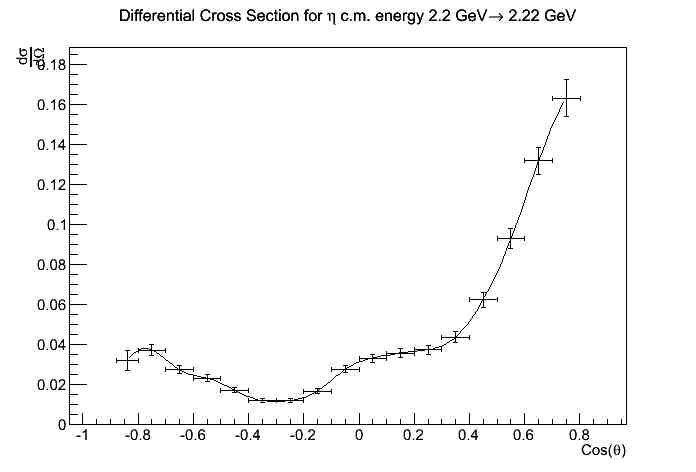
I then take this TGraph, and by using TSpline5, draw a histogram for PScatterCrossSection, see figure below.
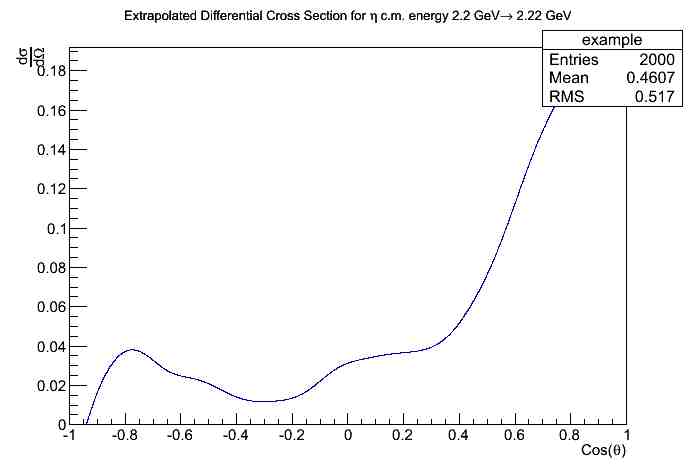
I then use this histogram as seen in the sample macro
Input: _x is c.m. cos(theta), _y is the dsig/dcos(theta)
Output: _f: cross section
model->AddHistogram(example,"value = Eval(_x); _f = _y * value");
The output of PLUTO generated looks nothing like the inputted, as it can be seen from the first 2 figure to that of the figure below
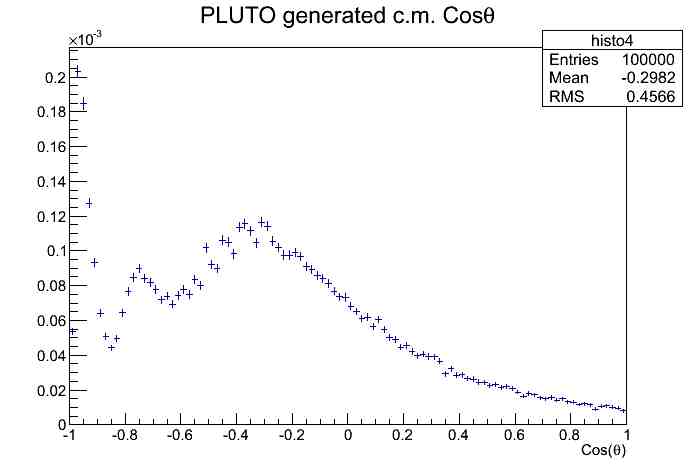
Moreover, the macro I use stipulates the c.m energy range as
model->SetRange(2.2,2.22); //in GeV
which corresponds to 2.11 to 2.16 GeV beam energy in lab frame for the reaction g p -> p eta.
As can be seen from the figures below, from using the functions
my_reaction.Do(histo1,"_x = [g+p]->M()");
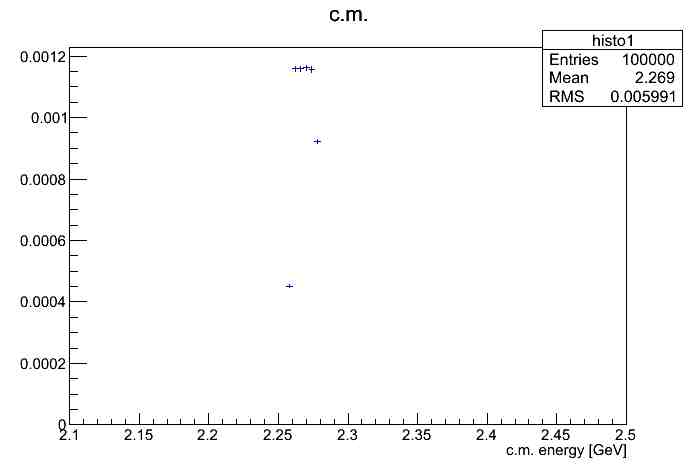
for c.m. energy, and
my_reaction.Do(beamProfile,"_x = ([g+p]->GetBeam())->E();");
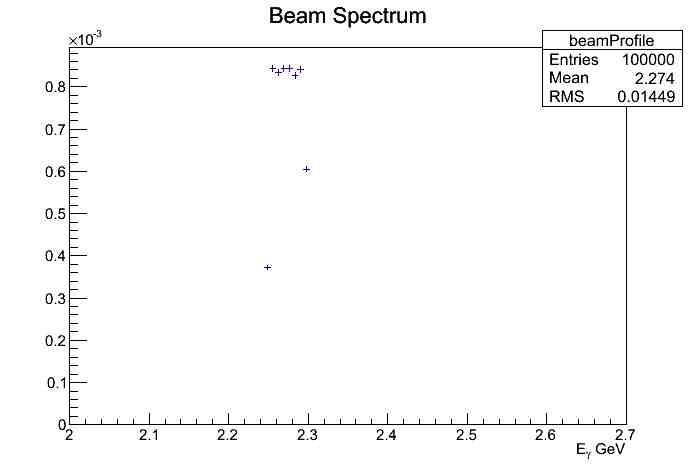
for lab energy, neither of these plots correspond to the input given in the macro.
I can no longer attach any more files, so I am adding my macro in the text body.
Another note, when using ROOTs ALCiC to compile the macro, I had to add these lines into the PScatterCrossSection.h
#include "/Users/Mike/Pluto/pluto_v5.40.5/src/PAngularDistribution.h"
#include "/Users/Mike/Pluto/pluto_v5.40.5/src/PProjector.h"
#include "/Users/Mike/Pluto/pluto_v5.40.5/src/PF2EvalBatch.h"
Here is my macro
#include "TGraphAsymmErrors.h"
#include "TH1.h"
#include "TH2.h"
#include "TH3.h"
#include "TChain.h"
#include "TCanvas.h"
#include "TF1.h"
#include "TGraphAsymmErrors.h"
#include "/Users/Mike/Pluto/pluto_v5.40.5/src/PParticle.h"
#include "/Users/Mike/Pluto/pluto_v5.40.5/src/PReaction.h"
#include "/Users/Mike/Pluto/pluto_v5.40.5/src/PBeamSmearing.h"
#include "/Users/Mike/Pluto/pluto_v5.40.5/src/PAnyDistribution.h"
#include "/Users/Mike/Pluto/pluto_v5.40.5/plugins/scatter_mod/PScatterCrossSection.h"
// 2.2 - 2.22
void eta_XSection()
{
//From data on eta differential cross section as function of c.m. cos(theta) for c.m. energy 2.2 -> 2.22 GeV
//Making a TGraph then fit the TGraph to a spline
const int p7694_d47x1y1_numpoints = 17;
double p7694_d47x1y1_xval[p7694_d47x1y1_numpoints] = { -0.84, -0.75, -0.65, -0.55, -0.45, -0.35, -0.25, -0.15, -0.05, 0.05, 0.15, 0.25, 0.35, 0.45, 0.55, 0.65, 0.75 };
double p7694_d47x1y1_xerrminus[p7694_d47x1y1_numpoints] = { 0.040000000000000036, 0.050000000000000044, 0.04999999999999993, 0.04999999999999993, 0.04999999999999999, 0.050000000000000044, 0.04999999999999999, 0.05000000000000002, 0.05, 0.05, 0.04999999999999999, 0.04999999999999999, 0.04999999999999999, 0.04999999999999999, 0.050000000000000044, 0.050000000000000044, 0.050000000000000044 };
double p7694_d47x1y1_xerrplus[p7694_d47x1y1_numpoints] = { 0.039999999999999925, 0.050000000000000044, 0.050000000000000044, 0.050000000000000044, 0.04999999999999999, 0.04999999999999999, 0.04999999999999999, 0.04999999999999999, 0.05, 0.05, 0.05000000000000002, 0.04999999999999999, 0.050000000000000044, 0.04999999999999999, 0.04999999999999993, 0.04999999999999993, 0.050000000000000044 };
double p7694_d47x1y1_yval[p7694_d47x1y1_numpoints] = { 0.0324, 0.0374, 0.0276, 0.0233, 0.0173, 0.0122, 0.0122, 0.0169, 0.0277, 0.0333, 0.0359, 0.0375, 0.0439, 0.0625, 0.093, 0.132, 0.1634 };
double p7694_d47x1y1_yerrminus[p7694_d47x1y1_numpoints] = { 0.005, 0.00291, 0.00185, 0.00166, 0.00139, 0.00102, 9.7E-4, 0.00117, 0.00178, 0.00205, 0.00215, 0.00217, 0.00258, 0.00386, 0.005, 0.0069, 0.0093 };
double p7694_d47x1y1_yerrplus[p7694_d47x1y1_numpoints] = { 0.005, 0.00291, 0.00185, 0.00166, 0.00139, 0.00102, 9.7E-4, 0.00117, 0.00178, 0.00205, 0.00215, 0.00217, 0.00258, 0.00386, 0.005, 0.0069, 0.0093 };
double p7694_d47x1y1_ystatminus[p7694_d47x1y1_numpoints] = { 0.0, 0.0, 0.0, 0.0, 0.0, 0.0, 0.0, 0.0, 0.0, 0.0, 0.0, 0.0, 0.0, 0.0, 0.0, 0.0, 0.0 };
double p7694_d47x1y1_ystatplus[p7694_d47x1y1_numpoints] = { 0.0, 0.0, 0.0, 0.0, 0.0, 0.0, 0.0, 0.0, 0.0, 0.0, 0.0, 0.0, 0.0, 0.0, 0.0, 0.0, 0.0 };
TGraphAsymmErrors *p7694_d47x1y1 = new TGraphAsymmErrors(p7694_d47x1y1_numpoints, p7694_d47x1y1_xval, p7694_d47x1y1_yval, p7694_d47x1y1_xerrminus, p7694_d47x1y1_xerrplus, p7694_d47x1y1_yerrminus, p7694_d47x1y1_yerrplus);
p7694_d47x1y1->SetTitle("Differential Cross Section for #eta c.m. energy 2.2 GeV#rightarrow 2.22 GeV"); ///HepData/7694/d47x1y1
p7694_d47x1y1->GetXaxis()->SetTitle("Cos(#theta)");
p7694_d47x1y1->GetYaxis()->SetTitle("#frac{d#sigma}{d#Omega}");
TCanvas *TgCan = new TCanvas("TgCan","TgCan");
TgCan->cd();
p7694_d47x1y1->Draw("AP");
TSpline5 *s3 = new TSpline5("s3",p7694_d47x1y1);
s3->Draw("same");
//Now from the spline, create a TH1D histogram for PLUTO to model the Xsection with
TH1D *example = new TH1D("example","try this",2001,-1,1);
example->SetTitle("Extrapolated Differential Cross Section for #eta c.m. energy 2.2 GeV#rightarrow 2.22 GeV"); ///HepData/7694/d47x1y1
example->GetXaxis()->SetTitle("Cos(#theta)");
example->GetYaxis()->SetTitle("#frac{d#sigma}{d#Omega}");
example->Sumw2();
int hold = 1; //place value for histogram bin filling
//############Filling Histogram#########################
for (double j = -1.; j<=1.; j = j +0.001) {
double bin_content = s3->Eval(double(j));
if(bin_content < 0.0){bin_content = 0.0;}
//cout<<bin_content<<endl;
example->SetBinContent(hold,bin_content);
hold++;
}
//################################################
TCanvas *canf = new TCanvas("canf","canf");
canf->cd();
example->Draw("ep");
//PLUTO TIME
PScatterCrossSection * model = new PScatterCrossSection("mymodel","My cross section");
model->Add("g,grandparent,beam");
model->Add("p,grandparent,target");
model->Add("q,parent");
model->Add("p,daughter");
model->Add("eta,daughter,primary");
//Define the range of the c.m. sampling:
model->SetRange(2.2,2.22); //CLAS G12 c.m. model->SetRange(1.739,3.3268);
//model->AddEquation("my_x = s3->Eval(_x);;_f = Eval(my_x)");
model->AddHistogram(example,"value = Eval(_x); _f =_y * value");
makeDistributionManager()->Add(model);
PReaction my_reaction("_P1 = 2.113","g","p","p eta [dilepton [e+ e-] g]");
TH1F * histo1 = new TH1F ("histo1","c.m.",100,2.1,2.5);
histo1->Sumw2();
histo1->GetXaxis()->SetTitle("c.m. energy [GeV]");
my_reaction.Do(histo1,"_x = [g+p]->M()");
TH2F * histo2 = new TH2F ("histo2","c.m. vs cos_theta",100,1.0,3.0,20,-1,1);
my_reaction.Do(histo2,"_x = [g+p]->M(); myeta = [eta]; myeta->Boost([g+p]); _y = myeta->CosTheta()");
//This histogram shows the beam profile:
TH1F * beamProfile = new TH1F ("beamProfile","Beam Spectrum",100,2.0,2.7);
beamProfile->Sumw2();
beamProfile->GetXaxis()->SetTitle("E_{#gamma} GeV");
my_reaction.Do(beamProfile,"_x = ([g+p]->GetBeam())->E();");
TH1F * histo4 = new TH1F ("histo4","PLUTO generated c.m. Cos#theta",100,-1,1);
my_reaction.Do(histo4,"myeta->Boost([g+p]); _x = myeta->CosTheta()");
histo4->GetXaxis()->SetTitle("Cos(#theta)");
histo4->Sumw2();
my_reaction.Print();
my_reaction.Loop(100000);
TCanvas *can1 = new TCanvas("can1","can1");
can1->cd();
histo1->Draw();
TCanvas *can2 = new TCanvas("can2","can2");
can2->cd();
beamProfile->Draw("ep");
TCanvas *can3 = new TCanvas("can3","can3");
can3->cd();
histo4->Draw("ep");
//TgCan->Print("XSection_Data.jpeg");
//canf->Print("XSection_Interpolated.jpeg");
//can1->Print("PLUTO_generated_cm_energy.jpeg");
//can2->Print("Beam_Profile.jpeg");
//can3->Print("PLUTO_generated_cos_theta.jpeg");
}
Thanks for all the help
Michael
[Updated on: Thu, 23 August 2012 05:09] Report message to a moderator |
|
|
|
Current Time: Mon Jul 14 22:39:18 CEST 2025
Total time taken to generate the page: 0.00937 seconds
|
 GSI Forum
GSI Forum





